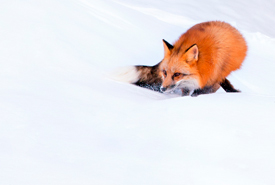
Red fox (Photo by Alex Badyaev)
Red fox
Despite their perceived boldness and cunning in children’s stories, including Fantastic Mr. Fox, red foxes are shy but curious by nature.
What does it look like?
The red fox is a small mammal known for its rusty-red colour, sharp pointed face and a light build that allows it to be agile. While most red foxes have red fur, other colour variations may occur, including brown, silver and black. Red foxes have black ears and paws and a white throat, tail tip and underparts. A long, bushy tail measures up to one-third of its total length.
Where does it live?
Red foxes are one of Canada’s most widespread species. They can be found across the country, except the high Arctic and islands off BC’s coast. Their wide distribution can be attributed to their adaptability to a diverse range of habitat types, including both natural and human environments. Forests, prairies, farms and cities are just some of the places this species is found.
What does it eat?
As a mainly nocturnal animal, much of this species’ hunting is done at night. Red foxes are omnivores, which means their diets change depending on the season and their range. During winter months, this skilled predator generally hunts small mammals, such as mice, squirrels, lemmings and rabbits. The species will also scavenge carrion.
Red foxes are great hunters, due to their acute eyesight, hearing and sense of smell. These foxes can trace prey by the slightest movement, such as a rabbit’s ear twitching or a mouse moving its tail.
In the summer, berries, earthworms and insects are also part of this species’ diet.
What is NCC doing to conserve habitat for this species?
Red foxes can be found on almost every Nature Conservancy of Canada (NCC) property. For example, in Saskatchewan, NCC is caring for 13,088 acres (5,297 hectares) at the Old Man on His Back Prairie and Heritage Conservation Area for many species, including red fox. In PEI, NCC is protecting 55 acres (22 hectares) of salt marsh and coastal forest along the Enmore River. This area is in one of only two forested wildlife corridors remaining on the island and is important habitat for red fox, ruffed grouse, snowshoe hare and many species of birds.
Other NCC properties where this fox species can be found include:




